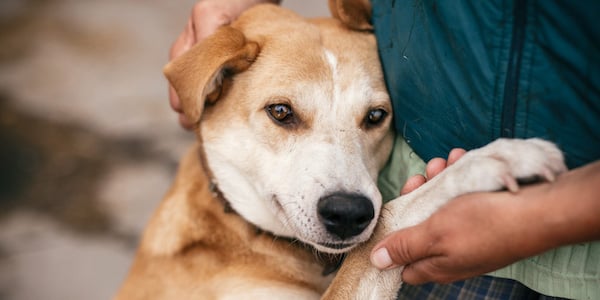 Euthanizing a dog for medical reasons has long been seen as a way to ease their suffering. But putting a dog down for a behavioral issue — like aggression — is a conversation fraught with big feelings, opinions, and controversy.
Euthanizing a dog for medical reasons has long been seen as a way to ease their suffering. But putting a dog down for a behavioral issue — like aggression — is a conversation fraught with big feelings, opinions, and controversy.
The argument swings between "save them all" and "euthanize all risks." But in reality, it is never this simple.
Fortunately, over the last couple of years, the topic of behavioral euthanasia has started to be more openly discussed within the training and rescue community, but there's still a long way to go.
There is quite a bit of stigma and judgment not only against dog owners who have made the hard decision to euthanize their dog due to behavior issues but also towards rescues or shelters, dog trainers, canine behavior consultants, and veterinarians involved in those cases.
The decision to euthanize a dog for aggression is never made lightly. No one wants to make the decision to put a dog down. But someone has to when it comes to certain cases where there are no other viable options. And the people who do make that decision deserve compassion and support. The alternative is to pass along that decision to others — to another family, a shelter, a different rescue — usually with the risk of putting people or animals in danger. This is called "outsourcing" euthanasia, and it's something that needs to be avoided.
In this article, I want to explain behavioral euthanasia, when it's a consideration for a dog guardian or caretaker, and how I approach it with my clients. Whether you are considering this choice for your own dog or you work or volunteer with a rescue organization that may need to make these decisions, it shouldn't be something that you face alone.
Table of Contents
What Is Behavioral Euthanasia?
Behavioral euthanasia is humanely ending a dog's life because of severe behavioral issues, such as aggression or extreme anxiety. Humane euthanasia is done by a veterinarian.
Dogs who are put down due to behavior problems are often young and healthy, which makes this outcome so difficult for many to understand or even think about as an option. One Australian study found that 29.7% of euthanasias for dogs aged three and under were due to undesirable behaviors. A British study found similar results in their review of euthanasia for dogs in the same age range.
While a dog may not be noticeably suffering physically, they may:
- Be suffering mentally and have a low quality of life due to the management requirements for their behavior
- Present a high bite risk towards humans or other pets in the home
- Present a high bite risk towards humans or other animals outside of the home
Behavioral euthanasia should not be considered for "nuisance behaviors" or dog training issues such as pulling on a leash, barking, destructive chewing, digging, etc.
In my experience working on aggression cases, it is often the human client, not myself, that brings up the question of whether they should euthanize their dog. It is rare for me to bring it up first, but if I do, I frame it in the context of what all of the options are for behavior cases:
- Do nothing
- Manage the environment to prevent the behavior
- Behavior modification (paired with management)
- Rehoming
- Euthanasia
These five options are the only options that any dog owner has when dealing with a behavior issue, whether it's a simple or complex case.
My goal in situations where behavioral euthanasia is or should be considered is to provide an overview of what the options are, give a professional prognosis for a dog's specific case, and provide support no matter what the decision may be. I believe that it is unethical for me as a dog trainer or behavior consultant to tell them that they should put their dog down. That is not my decision to make. My job is to make sure they understand the potential risks and liabilities of living with an aggressive dog as well as what options may still be worthwhile to try.
Putting a Dog Down for Aggressive Behavior
If your dog exhibits extreme or unpredictable aggressive behavior, it's important to connect with a certified canine behavior consultant and/or a board-certified veterinary behaviorist for support and guidance.
These types of behavior cases require a higher skill and experience level, so I recommend looking for a higher level of certification than a certified professional dog trainer. Read about the differences between dog behavior consultant certifications here.
Gathering History About the Case: Putting the Aggression in Context
There are many variables in a dog's behavior case that a professional will take into account. The following are just a few of the factors that affect the risk factors of keeping the dog in the home or adopting it out to a new family:
- Health Issues: Are there any underlying medical issues that could be contributing to the dog's aggression? Pain often plays a huge role in aggressive behavior, and treatment for medical issues may reduce the risk of aggression.
- Dog Information: What are the age, size, and breed of the dog? This can inform the potential damage if there is a bite incident and overall risk to the community.
An important component is looking at whether the dog's instinctual needs are being met. Are they lacking mental enrichment and exercise? Do they have appropriate outlets for normal –– but often undesired by people –– canine behaviors? - Home Environment: What family members are present in the home? Are they at higher risk due to their age or size? Are they competent in understanding and implementing safety management? The presence of children or the elderly automatically increases risk factors for aggression cases.
- Target of Aggressive Behavior: Towards whom or what is aggression directed? Familiar people or strangers? Other animals, familiar or unfamiliar?
- Risk Assessment: What risk does the dog present to the community around their home? Has the dog been declared "potentially dangerous" by their local animal control or required quarantine after a bite incident? What level of risk is there in the home toward family members or friends?
Putting a dog down for behavior should not be a "snap" decision. In most dog aggression cases, there is quite a lot that can be done prior to even considering behavioral euthanasia for the dog.
Rehoming or putting a dog down for aggression should not be a decision made in the highly-emotional time right after an incident unless the safety risk is high and no other alternatives are available.
When Does Behavioral Euthanasia Become an Option?
 Behavioral euthanasia may be something to consider when the following issues arise:
Behavioral euthanasia may be something to consider when the following issues arise:
- Will required management for safety severely limit the dog's quality of life?
- If the dog escaped their home or other safety management, are they an immediate risk to people or pets?
- Would rehoming the dog place the new family at risk of being bitten?
- Are the requirements for an ideal and safe home for the dog incredibly limiting? (For example, a dog will only do well in a remote or rural home with no visitors, no other pets, only female or male owner(s), or only owners with extensive experience in dog training and defensive handling. These "unicorn" adoptive homes are essentially non-existent.)
Often, the most informative questions to consider are: Would I want to live next door to this dog? Would I want to live with this dog myself (if I weren't already the owner)? Would I feel safe around this dog?
Euthanasia for Other Behavioral Issues
Behavioral euthanasia is not limited to aggression. A dog may be suffering mentally from issues like severe separation anxiety, extreme fear, or may engage in self-harm behaviors that greatly affect their quality of life. In these cases, euthanasia may be considered after exploring other treatments. I highly recommend connecting with a board-certified veterinary behaviorist in conjunction with a certified canine behavior consultant for these types of cases, as they often require medication and intensive behavior modification.
Medical Issues & Dog Aggression
Sometimes what looks like aggression is actually a symptom of an underlying medical issue — and getting to the root of that can make a huge difference.
Pain is a big one, and in my experience, is a contributing factor in the majority of aggression cases. Dogs dealing with arthritis, dental problems, neurological issues, or even undiagnosed injuries may lash out because they’re uncomfortable or trying to protect themselves. Vision or hearing loss can also contribute to fear-based reactions.
In these cases, treating the pain or managing the condition can reduce or potentially eliminate the aggressive behavior. It’s also worth considering that hormonal imbalances, thyroid disorders, or cognitive decline (especially in senior dogs) can affect how a dog reacts to their environment. Working with your vet to rule out or treat any medical issues, and possibly adding a veterinary behaviorist, is a crucial part of many aggression cases.
What Are the Alternatives to Behavioral Euthanasia for a Dog?
Strict Environmental Management
Whether on its own or combined with training and behavior modification, management of the environment is all about making everyone as safe as possible. For certain aggression issues, such as resource guarding, this may be as simple as only feeding the dog in their crate at mealtimes and making sure no one in the family approaches. Or management may require two layers of separation between pets in the home to prevent altercations, such as two hardware-mounted gates between their own areas with visual blocks.
When practicing separation between pets, it's important to think through the entry and exit protocols for people coming and going into those spaces, as well as how you would move the dogs outside for potty breaks, etc. Simply setting up a crate for one dog to be in while the other roams around the same room is not the answer. Not only does this severely affect the quality of life for the crated dog, but it also can increase tension and contribute to worsening behavior.
Management may include training a dog to wear a basket muzzle and always having them wear it when they leave the house on a leash. It may mean never taking them for regular dog walks around the neighborhood, instead providing exercise and mental enrichment at home only. It may be not ever having visitors over to your home. Management may also include incorporating prescription medications for anxiety.
But the truth is that management is never 100%. Management can and will likely fail at some point. Someone may leave a gate or door open. A gate latch may not fully close.
Legal Liability
One must always consider the "what if?" What if management fails and the dog gets out of the yard? What if another neighborhood pet found their way into your yard unexpectedly? What if a friend or family member entered your home without you there? Could you live with the potential consequences and liability if the worst-case management failure happened?
Along with the emotional side of managing an aggressive dog, there are some serious legal things to keep in mind. In a lot of places, if your dog bites someone — even just once — you could be held legally responsible, whether or not your dog has shown aggression before.
Some states have strict liability laws, which means you're on the hook no matter what. Others follow the "one bite rule," but once your dog has a known history, the legal risks go way up. That could include being sued, your homeowner’s insurance dropping you, or even being forced to give up your dog if they're labeled dangerous by local authorities.
Training for Aggressive Behavior
Many types of aggression can successfully be treated. However, true behavior change takes commitment and time, typically months or longer. And one must practice strict management while implementing a training plan to prevent rehearsal or regression.
A behavior consultant or veterinary behaviorist will walk you through the methods of behavior modification, which will likely include counterconditioning and differential reinforcement of alternative or incompatible behaviors (DRI/DRA/DRO). These focus on changing your dog's emotional response towards the person or thing that triggers their aggression and teach your dog what to do instead of aggressing. Within each of these methods are a variety of techniques and protocols depending on the type of aggression and your individual dog.
Aggression Between Dogs in a Home
Intra-household dog aggression — aggression between dogs who live in the same home — is often the most difficult type of aggression to treat. There are quite a few factors that affect the treatment outcome of intra-household dog aggression. If you have two dogs exhibiting aggression towards each other in your home, you must connect as soon as possible with a qualified professional. In these cases, rehoming one of the dogs may end up being the safest choice.
Rehoming
Depending on what triggers a dog's aggression, finding a new home for them can certainly be an option. For dog-directed or animal-directed aggression, it may be possible to rehome a dog to a family with no other pets. Or a dog who becomes anxious and then fearfully aggressive towards children may be happy and stable in a home with no children or visiting children.
However, finding a home for dogs that have severe bite histories or require extensive management and handling is much more difficult, and then one must consider whether it's ethical to pass the risk to another person. Keep in mind that dogs who are aggressive toward people who are rehomed still present a liability risk to shelters, rescues, or previous owners if an incident were to occur in the future.
It's really important to be upfront if you're considering rehoming — hiding your dog’s bite history can come back to bite you. If you're feeling unsure, talking to a lawyer or learning about your local laws can help you make more informed decisions.
Many no-kill shelters find that they cannot find a foster or adoptive home for dogs with these extensive behavioral needs, which results in years of staying in a shelter environment, safety risk to staff and volunteers, escalation of behavioral issues, and overall low-quality life for the dogs themselves.
The resources required to care for this one dog also mean that a shelter cannot provide for multiple, less dangerous dogs. Hence why many no- or low-kill shelters will not accept dogs with bite histories.
Learn more about how to responsibly rehome a dog here.
Dog Sanctuary
There may be a dog sanctuary in your area that is equipped to house your dog for the remainder of their life. However, sanctuaries are few and far between, and even rarer are sanctuaries that can provide a good quality of life and safe, sanitary living conditions for the dogs in their care. Contact your local shelters and rescues to inquire about potential sanctuary locations in your area.

Finding Support
If you find yourself considering behavioral euthanasia for your dog, or your dog's behavior consultant or veterinarian has brought it up as a potential outcome, please know that my heart is with you. It is not an easy decision. But it ultimately is your decision.
Surrounding yourself with support will help you through the decision process and after making the decision to euthanize a dog for behavior. This is not something you need to deal with alone, and resources are available for you. Reach out to a canine behavior consultant, veterinary behaviorist, or even your own therapist.
Connecting with a professional who works with these complex behavioral cases can give you an idea of what management would be necessary and what a behavior plan would entail. This information helps you gauge what the best option for you and your dog may be and learn what immediate management to implement for safety.
If you are looking for support, whether in addressing your dog's behavioral issues or if you are considering behavioral euthanasia, I am happy to connect with you virtually. Please know that you are not alone.
More Resources for Dog Owners
Free Download: Guidance & Grace Rehoming & Behavioral Euthanasia Workbook (A self-paced workbook that walks you through reflections, quality of life, options, and more)
Facebook Group: Losing Lulu (A support group for dog owners who have made the heartbreaking decision to euthanize a dog for behavior)
Lap of Love: Behavioral Euthanasia Support Group (Held on the 4th Wednesday of every month; pre-register up to 12 days in advance)
Euthanasia for Behavior Part One: Changing the Culture (I also highly recommend reading Part Two)
CAAB Chat Podcast: Behavioral Euthanasia with Trish McMillan
More Resources for Shelters and Rescues
American Pets Alive! The Only Protocol You'll Ever Need for Making Behavioral Euthanasia Decisions
The Perils of Placing Marginal Dogs
The IAABC Journal "Euthanasia in Shelters: Data and Decision Making"






